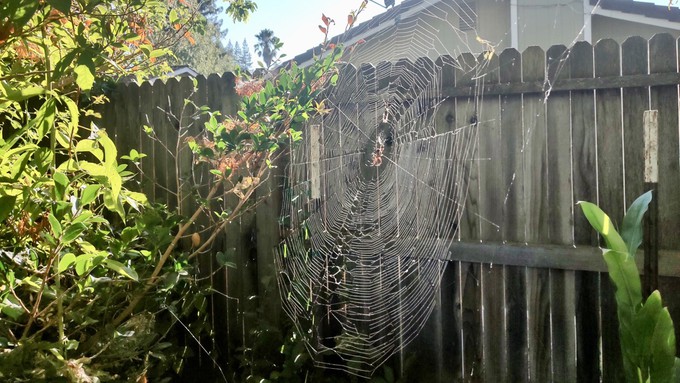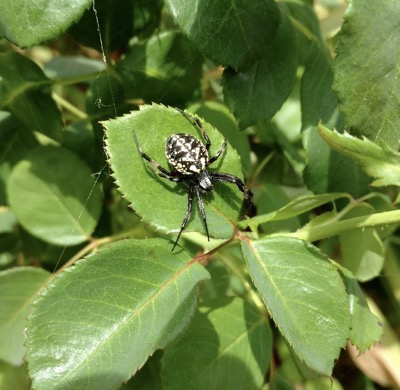
They only look scary (and they eat lots of bugs)

This is the web of a golden orbweaver spider. They like to hang out during the day under the leaves of large rose bushes. Debbie Arrington
Huge spider webs – each more than 6 feet across – block both ends of the path next to my raised beds. Similar silky masterpieces span rose bushes or go up into trees.
Between potted tomatoes, I walked into one web by accident, its fine silk quickly sticking to my clothes. I screamed when I saw its maker on my shoulder: A giant golden orbweaver.
(I managed to set it down gently on a different bush.)

This late summer, my garden has become a spider wonderland, and that’s a good thing. Spiders are natural pest control; they eat lots of bugs.
Many of them are golden orbweavers, capable of constructing webs as wide as double doors. I counted eight different orbweavers in my backyard in one morning. I don’t doubt they’re related.
Harmless to people, this particular variety is fond of large rose bushes, such as those growing all over my garden. I have more than a hundred in the ground.
“They like to hide out under leaves on the rose bush during the day,” explained Baldo Villegas, Sacramento’s Bug Man, when I asked him about these spiders a few years ago. “That’s where it’s nice and cool.”
The retired state entomologist has encountered many, many spiders. In Sacramento, we only need to worry about widows. They have a venomous bite.
“In the Sacramento area, the black widow spiders are the most dangerous as they are very common,” Villegas said. “Next would be the brown widows, but they are much less common.”
The widows tend to be found outdoors or in garages in dark, dry, seldom-disturbed places. Brown recluses and hobo spiders, two other species that can hurt people, are not found in California.
Villegas likes jumping spiders (his favorite), crab spiders, garden spiders and cellar spiders (a.k.a. daddy long legs). All of them have a productive job eliminating unwanted pests.
“All spiders are predaceous on other critters, especially insects, and they are considered beneficial critters of the garden,” Villegas explained. “Most all spiders in our area are harmless to humans or pets. The only problem is when the spiders are grabbed or trapped by human hands! Then is when they can bite.”
Master gardeners consider garden-variety spiders as beneficial insects.
“Spiders are mostly beneficial because they feed on pest insects,” say the UC IPM research notes. “However, many people think that all spiders are dangerous and aggressive. In California, the main spider capable of causing serious injury is the black widow, which generally remains outdoors and out of sight. Spiders seen out in the open during the day are unlikely to bite people. Focus pest management efforts on removing webs and hiding places. Pesticides are not generally recommended.”
I used to jump whenever I saw spiders. Now I admire them – and I watch where I walk.
For more on spiders: https://ipm.ucanr.edu/QT/spiderscard.html.
Comments
0 comments have been posted.Sacramento Digs Gardening to your inbox.
Sites We Like
Garden Checklist for week of July 21
Your garden needs you!
* Keep your vegetable garden watered, mulched and weeded. Water before 8 a.m. to reduce the chance of fungal infection and to conserve moisture.
* Feed vegetable plants bone meal, rock phosphate or other fertilizers high in phosphate to stimulate more blooms and fruiting. (But wait until daily high temperatures drop out of the 100s.)
* Don’t let tomatoes wilt or dry out completely. Give tomatoes a deep watering two to three times a week.
* Harvest vegetables promptly to encourage plants to produce more. Squash especially tends to grow rapidly in hot weather. Keep an eye on zucchini.
* Pinch back chrysanthemums for bushy plants and more flowers in September.
* Remove spent flowers from roses, daylilies and other bloomers as they finish flowering.
* Pinch off blooms from basil so the plant will grow more leaves.
* Cut back lavender after flowering to promote a second bloom.
* It's not too late to add a splash of color. Plant petunias, snapdragons, zinnias and marigolds.
* From seed, plant corn, pumpkins, radishes, winter squash and sunflowers.